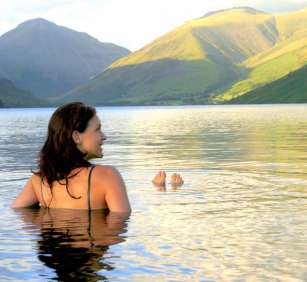Wild swimming is the age old practise of swimming in natural waters. With the abundance of water holes, outdoor pools, lakes, rivers and outdoor lidos, Daniel Start gives great advice on what should you consider when going wild swimming.
Skills – Strength: 5, Balance: 1, Flexibility: 1, Agility: 1, Coordination: 4
Time needed: travelling time + 1 hour, Cost to try: £Free
What is Wild Swimming?
Daniel Start, author of the book Wild Swimming, writes that ever since the late Roger Deakin swam through Britain by river, lake and sea the term ‘wild swimming’ has been used to describe the age-old practise of swimming in natural waters – river swimming and other outdoor swimming. In our grandparents” day swimming holes were where people learnt to swim and congregated on a summer day – to paddle, picnic and play. Today there is a resurgence of interest in the traditional pleasure of wild swimming and people are learning to explore their rivers and lakes for swimming again.
Rivers are cleaner and more accessible than ever. You can spend the day with your friends swinging on a rope swing out over a pool and dropping into the cool water below. If you don’t know where to find a decent place to go wild swimming, use the link at the bottom of the page. Daniel Start has written a great book ”Wild Swimming” which gives details of some fantastic places to swim outdoors. Both his book and website give information on where to go and how to swim safely.
Is Wild Swimming for me?
A scorching hot summer’s day is a great time for wild swimming, and it can be exciting on rainy or cooler days too…
What if the water is cold?
Water temperatures can vary. Shallow lakes can get up to a balmy 25C in summer but mountain rivers may struggle to reach 20C. Much of the year outdoor waters are around 12C – 17C so the key is to arrive at the swimming hole so hot and sweaty you can’t wait to strip off and plunge in.
Plan a good hearty walk to get there, and put on lots of warm clothes before you arrive. Once you’re in the water it takes a few minutes before the cold feeling goes away, so persevere. In general, the more you swim in cold water the less you feel the cold and the greater the health benefits of what is called ‘cold adaptation’. Don’t stay in too long without a wetsuit, though, and definitely get out and warm up after 20 minutes or if you start to shiver. Put on warm clothes immediately after a swim and combine this with something active: walk up a hill or do some star jumps.
Wild Swimming Gear
What to wear when going wild swimming
You’ll have more confidence, and be better able to explore, if you have footwear (e.g. old trainers, jelly beans etc) and goggles. A normal surfing wetsuit, a sleeveless wetsuit top or a specialist triathlon wetsuit will all help you stay warm longer. Make sure you bring towels, a picnic rug, midge repellent, suntan lotion, sunhats and plastic bags for all your wet kit. Inflatables are popular but make sure people won’t drift away on them, especially non-swimmers. A proper buoyancy aid (about £40) is safer, and fun too.
Buy Costumes, Goggles and Wetsuits for Wild Swimming
Eskdale in the Lake District, UK, has some great places to go wild swimming. The river Esk has wonderful pools and waterfalls. The ”Tongue Pot” is a long emerald pool beneath a waterfall about an hours walk from the road. It has rock walls that are famous for jumping from.
If you want to go wild swimming in Yorkshire, Stainforth Force lies below the Stainforce Packhorse Bridge west of the village. It has shallow pools suitable for younger children, and decent places for jumping in.
Safety
Data from ROSPA shows that 95 per cent of all swimming drowning victims were male and many were teenagers. Make sure you don’t become one of them. When you go into any water, always check it is safe to do so. Make sure you know how deep it is and that the bottom is clear of debris. Don’t dive into the shallow bit! Always swim within your abilities and NEVER swim after having any alcohol. People often get into difficulties by becoming too tired to swim back to shore, or get tangled in weeds and debris under the water. It is best to stay within a short distance of where you can safely touch the bottom.
Find Out More About Wild Swimming
There are more wild swimming safety tips on Daniel Start’s website.
Whether you are planning on going wild swimming in the Peak District, Yorkshire, or elsewhere in the UK, follow these wild swimming links for more information on:
For lots more useful information on wild swimming in the UK, buy the book Wild Swimming
Buy Costumes, Goggles and Wetsuits for Wild Swimming
